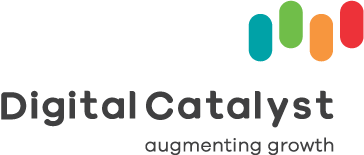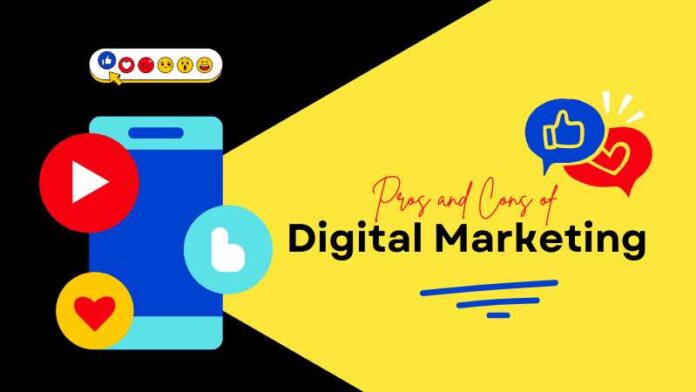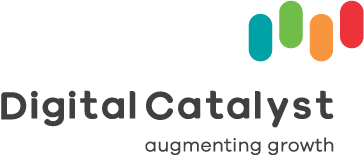Digital marketing is the art and science of using online platforms to reach potential customers. Businesses use it to sell products, build brands, and connect with audiences. Traditional marketing relies on TV, radio, and print ads. On the other hand digital marketing happens where people spend most of their time on screens, their mobiles and desktops.
A Quick Look at Digital vs. Traditional Marketing
| Feature | Digital Marketing | Traditional Marketing |
|---|---|---|
| Cost | Lower (Facebook Ads, SEO) | Higher (TV, Radio, Billboards) |
| Targeting | Precise (Age, Interests, Location) | Broad (Mass Audience) |
| Tracking | Real-time analytics | Delayed, Hard to Measure |
| Interaction | Two-way (Comments, Shares, DMs) | One-way (TV Ads, Flyers) |
| Scalability | Quick adjustments | Fixed once launched |
A Google search, Instagram story, or email newsletter are examples of digital marketing. The topmost strengths of digital marketing is the data and the way we can measure every dollar spent online. Digital footprint is left behind by every ad clicks, website visit, and social media share. Marketers use this data to –
- Analyze customer behavior.
- Identify trends and patterns.
- Segment audiences.
- Data driven campaign ROI optimization.
- Enhancing user experience.
- Conversion rate improvements.
- Guaging marketing trends analysis.
- Optimize ad spend effectively.
How Digital Marketing Works
Imagine running a bakery in New York. You could rely on foot traffic and word-of-mouth. But with digital marketing, you can:
- Show Google Ads when people search for “best cupcakes in NYC”
- Run Facebook promotions targeting dessert lovers within 5 miles
- Use email newsletters to remind past customers about seasonal flavors
- Rank on Google primarily Google Business Profile for “homemade brownies near me” through SEO
This strategy makes small businesses look big and big companies feel personal.
The Big Channels in Digital Marketing
Digital marketing is not one thing. It is a mix of platforms and strategies. Each serves a unique purpose:
- Search Engine Optimization (SEO) – Ranking on Google without paying for ads.
- Pay-Per-Click (PPC) – Paid ads on Google, Facebook, and beyond.
- Social Media Marketing – Grow a brand on Instagram, Twitter, LinkedIn.
- Email Marketing – Data driven personalized messages in inboxes.
- Content Marketing – Blog posts, videos, and infographics to educate and attract.
- Affiliate Marketing – Paying others to promote your products primarily sales from the marketing accounts/websites they own.
- Influencer Marketing – Partnering with people who have large audiences, letting them promote your products and services.
- Video Marketing – YouTube, TikTok, Instagram Reels for engagement.
Why Digital Marketing Matters
- 81% of people research products online before buying (Oberlo, 2023).
- Google handles 8.5 billion searches a day (Internet Live Stats).
- Facebook and Instagram ads reach over 3.065 billion users monthly (Backlinko).
Businesses who ignore digital marketing are like shops in the middle of a desert. They exist, but are seldom seen or heard. People might find you, but not as many as you would like.
Digital marketing isn’t magic. It’s a toolbox. Businesses that use the tools properly, such as SEO, ads, email, content, etc., win. Businesses that fail to leverage their power risk getting buried under millions of competitors fighting for the same audience.
Advantages of Digital Marketing
Marketing has changed. A few decades ago, businesses spent millions on TV and newspaper ads, hoping the right people would see them. Today, digital marketing flips that model. Instead of shouting at a crowd, businesses can speak directly to the right people.
The benefits of digital marketing are huge. Let us break them down into simple points for easy understanding.
1. Cost-Effectiveness
Traditional marketing bleeds money. TV ads cost thousands per second. Billboards? Expensive and untrackable. Digital marketing cuts costs and increases control.
- Facebook ads start at $5 per day.
- Google PPC lets you pay only for clicks.
- SEO costs nothing if done in-house but brings long-term traffic.
Small businesses can compete with big brands by targeting people at the right time. There is no need for million-dollar budgets. One can always start for free and scale up as the business grows.
2. Global Reach
Digital marketing helps in selling anything, even if it is cupcakes in Tokyo even when you are sitting in Texas?
- SEO help businesses rank worldwide.
- Social media connects brands with global audiences.
- E-commerce platforms like Shopify and Amazon enable cross-border selling.
A local store can become an international brand – without opening physical locations.
3. Targeted Advertising
Have you ever searched for “running shoes” and seen shoe ads everywhere? That has targeted marketing in action.
- Google Ads matches searches with intent & retargeting follows past visitors about your brand.
- Facebook and Instagram target age, interests, and behaviors.
With traditional ads, businesses hope the right person sees them. Digital ads make sure they do.
4. Measurable Results & Analytics
In the past, businesses used to spend millions on print ads without any measurable outcomes. This is where digital marketing shines. It tracks everything.
- Google Analytics shows real-time data on visitors and conversions.
- Facebook Ads Manager tracks clicks, impressions, and ROI.
- Heatmaps reveal where users click on your site.
Data helps businesses adjust and improve instead of wasting money.
5. Engagement & Customer Interaction
- TV ads talk at people. Digital marketing talks with them.
- Social media allows direct conversations through comments and DMs.
- Live chat and chatbots provide instant support.
- Emails build relationships instead of just selling.
Customers expect businesses to respond fast. Digital marketing makes that possible.
6. Flexibility & Scalability
A traditional marketing campaign is set in stone. A billboard or TV ad cannot be changed once it is live. Digital marketing is fluid.
- Ads can be paused, adjusted, or scaled instantly.
- A small PPC budget can grow as results improve.
- SEO and content marketing bring compounding returns over time.
Small experiments can turn into big wins—without major risk.
7. Higher Conversion Rates
Website visitors are potential customers. However, most leave without buying. Digital marketing nudges them back.
- Landing pages with strong CTAs increase conversions.
- Retargeting ads bring visitors back to buy.
- Email sequences turn curious visitors into loyal buyers.
A well-optimized website can convert more visitors into sales than a physical store ever could.
Summary of Digital Marketing Pros
| Advantage | Why It Matters |
|---|---|
| Cost-Effective | Lower budget, higher ROI |
| Global Reach | Sell anywhere, anytime |
| Targeted Ads | Ads reach the right audience |
| Measurable Results | Data-driven decisions |
| Customer Engagement | Two-way conversations |
| Flexibility | Adjust campaigns instantly |
| Higher Conversions | More sales, less waste |
Digital marketing is a game-changer. It is fast, affordable, and insanely effective when done right. Businesses that use it smartly will grow. Those who ignore it will struggle.
Marketing is not about shouting louder. It is about speaking smarter.
Disadvantages of Digital Marketing
Digital marketing do sound perfect – low costs, global reach, targeted ads. However, there’s a catch.
Running digital campaigns is more than launching ads or writing blog posts. It is a constant battle against competition, algorithms, and user expectations. Businesses that fail to adapt waste money, lose customers, and struggle to grow.
Let us break down the downsides so you know what to expect.
1. High Competition & Saturation
The internet is noisy. Every second, brands fight for attention.
- Facebook ads reach 2.9 billion users, but ad space is limited (Mailchimp).
- Over 600 million blogs exist, making content ranking harder (Hostinger).
Winning in digital marketing means outperforming thousands of others. SEO, PPC, and social media require constant updates and fresh ideas.
If you post a blog and expect traffic without effort, you are dreaming.
2. Dependence on Technology & Algorithms
One Google algorithm update might drop a site’s traffic overnight. One Facebook policy change can ruin an ad strategy.
- Google’s SEO core updates happen multiple times a year.
- Facebook ads get rejected without much information about why in the first place.
- Instagram and LinkedIn constantly tweak organic reach rules making it difficult for marketers to adopt dynamically.
Businesses have very little control on the platforms they promote. They play by the rules and the rules that change often makes it difficult to predict ROI effectively.
3. Security & Privacy Concerns
In the recent changing times, people do not want being tracked. All the laws that have come up for this makes digital marketing harder.
- GDPR (Europe) and CCPA (California) are restricting data collection.
- Apple’s iOS 14.5 update killed Facebook’s ability to track users across apps.(Wired)
- Google plans to phase out third-party cookies by early 2025. (Google)
Marketing teams should balance data collection with user privacy. If one overstep happens, they might face legal trouble and customer backlash which might be painful and cost a ton.
4. Ad Fatigue & Consumer Skepticism
People see thousands of ads daily. They ignore most of them.
- 42% of internet users use ad blockers (Statista, 2024).
- Banner blindness makes people skip over display ads. (Outbrain)
- Google penalizes bad user experiences, including annoying pop-ups.
Consumers in the post covid era trust recommendations more than ads. This is why influencer marketing and word-of-mouth outperform traditional digital ads.
5. Requires Continuous Learning & Adaptation
Digital marketing is not a copybook of strategies. Strategies that work today fail tomorrow.
- SEO updates change ranking factors.
- Social media trends shift constantly.
- AI tools disrupt traditional marketing tactics.
Marketers must keep learning or get left behind. There is no set-and-forget strategy in digital marketing.
6. Risk of Negative Publicity
One bad tweet can go viral. One angry customer can start a social media storm.
- United Airlines lost $1.4 billion in market value after a PR crisis ( Fortune 2017).
- Pepsi’s Kendall Jenner ad sparked massive backlash (Forbes, 2017).
- Hashtag campaigns can get hijacked by critics.
Online reputation is fragile. One mistake can spread faster than good news.
Summary of Digital Marketing Cons
| Disadvantage | Why It’s a Problem |
|---|---|
| High Competition | Hard to stand out in a crowded market. |
| Tech Dependence | Platforms change rules often. |
| Privacy Concerns | Laws limit data collection. |
| Ad Fatigue | Consumers block and ignore ads. |
| Constant Learning | Strategies become outdated quickly. |
| Negative Publicity | Mistakes can go viral fast. |
Digital marketing is not easy. It is a fast-moving game that rewards those who adapt and punishes those who don’t.
The results can be incredible if you’re willing to learn, test, and improve. Digital marketing will burn your budget and break your spirit if you expect quick wins without effort.
The choice? Keep up, or get left behind.
How to Maximize the Pros & Minimize the Cons
Digital marketing works best when businesses play to their strengths and avoid their pitfalls. The trick isn’t spending more—it’s spending smarter.
Here is how to win without wasting money.
1. Use Data to Make Better Decisions
Guesswork is expensive. Data saves money.
- Use Google Analytics to track traffic and conversions.
- Check ad performance daily to adjust bids and targeting.
- Test different content formats and double down on what works.
Smart marketers study numbers, not assumptions.
2. Focus on Quality Over Quantity
Posting five weak blog posts will not help. One strong one will.
- Google prioritizes valuable content, not filler.
- A single well-researched article can rank for years.
- High-quality videos beat dozens of forgettable clips.
Content should solve problems—not just exist.
3. Adapt to Algorithm Changes
Google, Facebook, and Instagram change the rules often. Businesses that adapt survive.
- SEO rankings drop if you ignore updates.
- Facebook limits organic reach, so ads are essential.
- Email open rates fall if you do not personalize.
Marketing is not a set-and-forget game. It is a constant test-and-learn process.
4. Build a Brand, Not Just Ads
Great businesses are not built on clicks. They are built on trust.
- Nike sells a story, not just shoes.
- Apple’s marketing creates loyalty, not just purchases.
- People remember brands that connect emotionally.
Ads bring traffic. Branding keeps customers coming back.
5. Diversify Marketing Channels
A business that relies on one platform risks disaster.
- Google Ads get expensive fast.
- Facebook’s algorithm can kill organic reach overnight.
- SEO takes time but provides long-term results.
Spread your efforts. Email, SEO, paid ads, social media—all work together.
6. Respect Customer Privacy
Privacy laws are not going away. Businesses must adapt or lose trust.
- Be transparent about data collection.
- Offer opt-outs for tracking and email lists.
- Use first-party data, not just third-party cookies.
Consumers reward brands they trust.
Do’s & Don’ts of Digital Marketing
| Do | Don’t |
|---|---|
| Use data for decisions | Rely on guesswork |
| Create valuable content | Spam low-quality posts |
| Stay updated on trends | Ignore platform changes |
| Build brand trust | Focus only on ads |
| Diversify marketing channels | Depend on one source |
| Respect privacy rules | Violate customer trust |
Conclusion
Digital marketing isn’t hard, but it’s competitive. Businesses that learn, test, and adapt grow, while those that ignore trends fade away.
If you want more customers, trust, and results, think like a customer. Give them what they want, where they want it, when they need it.
The best marketing does not feel like marketing—it feels like helping.



